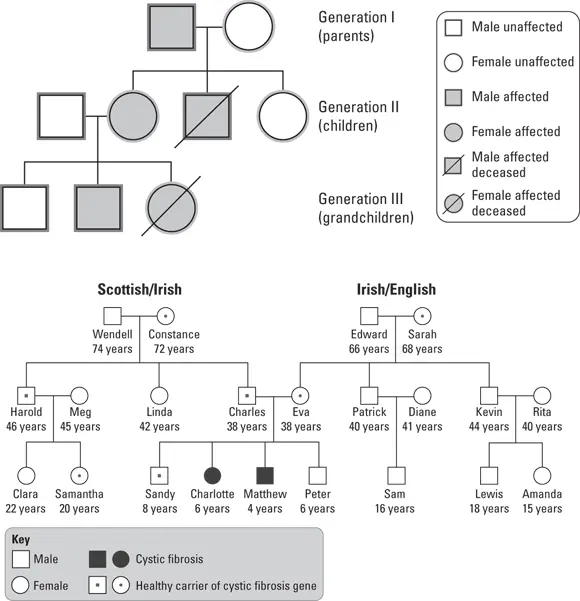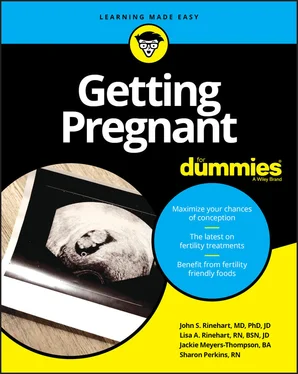Another type of problem can occur when there are too many copies of a three-letter word, for example egg (a genetic sequence). Fragile X syndrome is an example of this type of genetic error. Fragile X syndrome results when a region of a gene called the FMR1 gene has too many repeated sequences of the genetic word cgg. The FMR1 gene produces a protein that regulates other proteins to make normal nerve connections. The mutation can result in individuals with severe mental compromise. A family with members with severe mental compromise may benefit from genetic testing to determine whether the family has the abnormal FMR1 gene. A normal number of repeats is 5 to 50. If the sequence has more than 200 repeats, then the result is developmental abnormalities in varying degrees. However, where there are 50–200 repeated sequences, the person may have some developmental problems, or a female may have early ovarian failure. So experts often test a woman with premature ovarian failure to determine whether she has too many repeat sequences.
There are a number of single gene defects that affect the fertility of a person. These are being diagnosed more and more so the list is becoming quite long. It is beyond the scope of this chapter to fully explore these diseases.
Shaking the Family Tree for Information
The fact that genetics is playing a larger role in the cause and potential treatment of all diseases makes knowledge about families important. Doctors are now taking a more extensive family history, and if it seems warranted, they construct a genetic diagram (family tree; see Figure 3-2 for an example).

FIGURE 3-2:Diagram of genetic history.
Many people have at least one disease-causing genetic mutation if it occurs on both chromosomes. Fortunately, people have two chromosomes, so the mutation does not cause a clinical problem. But if two people have children and they both have the same mutation, then one out of four children may have the disease. A family tree may show relatives that had symptoms of the diseases which would put the couple on alert to test for the mutation.
Finding Out What’s in Your Genes
You may be asking why your fertility doctor would want to know all of the specifics of your genes and your partner’s genes (if you are using his sperm). As we explain earlier in this chapter, knowing more about a person’s genes provides many more clues about possible diseases. In infertility, knowing about your genes can help explain key questions such as why you are not getting pregnant, why you don’t make good embryos, or why you miscarry.
There are a number of tests that are used to gain information about a person’s genetic code. One test, called karyotyping, determines how many chromosomes are present. This can be done for people, a fetus, or embryos.
Remember that the chromosomes are long strings of genetic code that are tightly packaged, and there are 23 sets of chromosomes. Chromosomes 1–22 are called autosomes, while 23 is the sex chromosome. Each person has one set of chromosomes from each parent so there are 46 chromosomes arranged in 23 pairs. The sex chromosomes determine the sex of the person with XX being female and XY being male.
Until recently, testing chromosomes was laborious with cells being grown, stopped in their development, stained, photographed, and then counted. This process required a number of cells to be tested and was most commonly associated with an amniocentesis. The amniocentesis was done during the early second trimester to diagnose the presence of an abnormal number of chromosomes such as Down syndrome, which is trisomy 21, where the fetus has three copies of chromosome 21 (instead of two).
Recent developments in data analytics and molecular biology (next-generation sequencing) have permitted rapid chromosome determination in only a few cells (4–6) that can be taken from a five-day-old human embryo. The test is called preimplantation genetic testing for aneuploids. What’s an aneuploid? Glad you asked. When a cell has the correct number of chromosomes, it is called a euploid cell. But a cell can have too many chromosomes because it has the wrong number of sets of 23, such as a monoploidy or triploidy. If there is an incorrect number of any single chromosome, such as only one X chromosome (remember Turner’s syndrome with 45 XO or trisomy 21 with three number 21 chromosomes so 47, 21 +3), the cell is called an aneuploid cell. The value of karyotype testing is that it permits embryo selection such that embryos with the correct number of chromosomes can be transferred. This type of testing cannot correct the number of chromosomes an embryo has, so it does not increase the number of children that can result from an IVF cycle. But it can permit the transfer of embryos that have the highest chance of creating a pregnancy that can go to term. This reduces the time to conception and reduces the miscarriage rate.
There is controversy as to whether the use of preimplantation genetic testing for screening embryos is indicated, but many physicians and patients are opting for this diagnostic procedure. For some couples, the information from testing for chromosome number can help identify why a person has not conceived and may suggest either doing more cycles of IVF with the woman’s own eggs or may identify the need to move on to other options such as stopping treatment, adoption, or using donor eggs.
Spotting single gene defects
A second type of genetic testing can determine if a gene is abnormal. There may be a single nucleotide error, pieces of the gene may be missing or duplicated, or there may be other errors. The advent of next-generation sequencing has permitted easy, cost-effective testing for these errors. Genetic diseases may require that both chromosomes have the same defective gene. These diseases are called recessive. A person may have one defective gene, but the other normal gene compensates for the defective gene. Some genetic diseases require that only one chromosome have the gene defect, and these are call dominant gene diseases. One use of next-gen sequencing is for a family that has a history of a genetic disease. A person, who does not have the genetic disease or an embryo, can be tested for that disease. Since a person receives a chromosome from each parent, there is a double dose of each gene. The person who has a single gene defect is called a carrier for that gene, and the vast majority of these mutations are of the recessive type (requiring both sets of chromosomes to have the gene defect before the disease develops).
Suppose that the gene that is responsible for cystic fibrosis is faulty in the chromosome from one parent but normal in the other. Then the normal gene compensates for the malfunction of the other gene, and the person does not develop cystic fibrosis. The child of these parents may have one abnormal gene and one normal gene and is called a carrier for that gene defect. Sometimes, having one defective gene results in a disease. An example of this is Huntington’s chorea (a dominant gene disease), a devastating neurologic disease that does not show up until later in life after the person has reproduced. Huntington’s chorea is caused by a gene defect in which too many of the codons exist — similar to the type of problem in fragile X syndrome. The genetic defect for Huntington’s and fragile X is not due to an error in the code but rather to too much code. For families with a family history of Huntington’s, it is now possible to test embryos and elect not to transfer an embryo that has the defect.
Читать дальше













